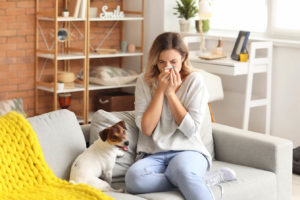How to Reduce Indoor Allergens in Your Home

While outdoor allergens often dissipate with cold weather, you may find that the sneezes and sniffles haven’t gone away! There’s a simple explanation for this — there are many allergens that live inside your home.
Also known as indoor allergens, these culprits can make your life miserable year-round. Indoor allergens include:
- Dust mites
- Pet dander
- Mold
- Cockroaches
Indoor Allergy Symptoms
 The symptoms of indoor allergens are the same as typical allergies associated with pollen and ragweed. Indoor allergy symptoms include:
The symptoms of indoor allergens are the same as typical allergies associated with pollen and ragweed. Indoor allergy symptoms include:
- Sneezing
- Wheezing and coughing
- Nasal congestion
- Difficulty breathing
- Itchy skin, nose, throat, or eyes
- Postnasal drip or runny nose
- Sinus infections
- Asthma
Prevent Indoor Allergens
Indoor allergens can be trickier to detect, but there are several things you can do in your home to reduce exposure, improve air quality, and treat your symptoms. While these measures differ slightly based on the specific allergen, there are a few things that apply to all:
- Keep your home clean and uncluttered.
- Use a dehumidifier and air purifier (with a HEPA filter).
- Change your air filters often.
Deal With Dust Mites
Dust mites are the most common trigger of indoor allergies and asthma. These microscopic, insect-like pests are invisible to the naked eye, but they can live anywhere in your home — from furniture to floors, hard surfaces to comfy carpets.
Dust mites resemble bugs (and are often confused with bed bugs), but they won’t actually bite your skin. They can, however, cause sneezing, congestion and sometimes even skin rashes.
If you’re experiencing indoor allergy symptoms triggered by dust mites, there are several ways you can take control of these pests:
- Vacuum and deep clean carpet and rugs often.
- Use a vacuum with a HEPA filter.
- Dust regularly, using a microfiber or electrostatic cloth.
- Use a certified allergen-capturing furnace filter.
- Replace air filters every one to two months.
- Wash all bedding once a week in hot water.
- Use allergen-proof covers on mattresses and pillows.
Dust mites like humidity and heat, so monitor the humidity in your home (the CDC recommends keeping it below 50% to reduce dust mites).
Prevent Pet Dander
Pet dander is another common trigger for allergies and asthma. Animals shed microscopic flecks of skin that can cause an allergic reaction in humans, with symptoms including a runny nose, sneezing, and itchy eyes.
Any animal with fur (or feathers!) can trigger this type of reaction, and most doctors recommend that people with animal dander allergies avoid having pets.
However, if you’re not ready to get rid of your furry friend, there are ways to reduce and avoid exposure to pet dander in your own home.
These include:
- Bathe and groom your pets often.
- After petting an animal, wash your hands with soap and water.
- Keep pets out of bedrooms.
- Vacuum carpets often, with a HEPA filter vacuum.
- Wash toys and animal beds regularly.
Eliminate Mold
Mold is a type of fungus that can grow indoors or outdoors, in moist places. The primary allergen in mold is the mold spore that is released into the air and inhaled through your nose, triggering an allergic reaction like rhinitis or asthma.
Mold is usually visible, but it tends to grow in places you don’t often look — dark basements, unknown leaks from the roof, and damp areas under carpets.
The key to avoiding mold spore exposure is preventing moisture buildup in your home. Some ways to do this:
- Monitor humidity in your home.
- Improve airflow through your rooms.
- Use a dehumidifier or central air conditioning.
- Use an air purifier with a HEPA filter.
- Fix leaks and remove sources of dampness.
- Clean mold immediately and wear a mask.
- Avoid running showers for long periods of time.
Control Cockroaches
Cockroaches have enzymes found in their saliva and excrement. These enzymes have been linked to allergic reactions in humans, and are one of the most common indoor allergens worldwide.
People with cockroach allergies experience similar symptoms to pollen or dust mite allergies, including coughing, sneezing, and nasal congestion. The most effective treatment is to prevent and remove these pests.
A few ideas to prevent cockroaches:
- Keep your home clean and uncluttered.
- Don’t leave food or garbage uncovered.
- Seal up areas where cockroaches can access water.
- Sweep floors and clean kitchen counters regularly to prevent food particles.
- Use traps, exterminators, or poison bait to kill cockroaches.
Prevent Pollen From Getting Inside Your House
Pollen is considered an outdoor allergen (found in trees and plants), but it can make its way into your home, living on surfaces and clothing and perpetuating your frustrating allergy symptoms.
There are simple things you can do in your home to reduce exposure to pollen indoors. These include:
- Keep windows and doors closed during high-pollen months.
- Change clothes and leave shoes outside after working outdoors.
- Wash bedding often.
- Use a HEPA air purifier.
- Change air filters often.
- Vacuum and sweep regularly.
Get Help
Indoor allergies can disrupt your life even more than outdoor allergies — you can’t often see them, you don’t know they’re there, and there’s no seasonal relief. It’s important to understand exactly what’s triggering your allergies, and to take preventative measures to avoid exposure.
Our allergy specialists at Advanced ENT & Allergy Center want you to experience freedom from your allergy symptoms. We’ll help you uncover the underlying cause of your symptoms, talk with you about ways to allergy-proof your home, and offer a treatment plan that will work for you.

